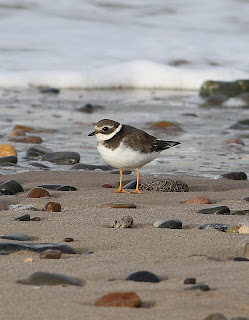I had to drive to Knott End where there was little to be had, even the high tide wasn’t due until after midday. But along the Esplanade a drake Eider had been grounded and disorientated by the overnight wind, rain and high tides. I took it into care, kept the poor thing in darkness in my quiet garage and released it a couple of hours later into the incoming tide. Very quickly it swam strongly out into the estuary, circled round and joined the other few Eider that were off the jetty.


The Common Eider, Somateria mollissima, is a large (50–71 cm body length) sea duck which is distributed over the northern coasts of Europe, North America and Eastern Siberia and some northern temperate regions, but winters further south in temperate zones, when it can form large flocks on coastal waters.
Eiders build their nests close to the sea, lining them with the celebrated eiderdown, plucked from the female's breast. This soft and warm lining was for a long time harvested for filling pillows and quilts, but in more recent years largely replaced by down from domestic farm-geese and synthetic alternatives. Although true eiderdown pillows or quilts are now a rarity, eiderdown harvesting continues and is sustainable, as it can be done after the ducklings leave the nest with no harm to the birds.
The Common Eider is characterized by its bulky shape and large, wedge-shaped bill. The male is unmistakable, with its black and white plumage and green nape. The female is a brown bird, but can still be readily distinguished from all duck, except other eider-species, on the basis of size and head shape. This duck's call is a pleasant "ah-ooo." The species is often readily approachable.
Drakes of the European, eastern North American and Asia/western North American races can be distinguished by minor differences in plumage and bill colour. Eiders dive for crustaceans and molluscs, with mussels a favoured food and eat mussels by swallowing them whole; the shells are then crushed in their stomachs and excreted. When eating a crab the Eider will remove all of its claws and legs and then eat the body in a similar fashion.
It is abundant, with populations of about 1.5-2 million birds in both North America and Europe, and also large but unknown numbers in eastern Siberia.
A particularly famous colony of eiders lives on the Farne Islands in Northumberland, England. These birds were the subject of one of the first ever bird protection laws, established by Saint Cuthbert in the year 676. About 1,000 pairs still nest there every year. Because St. Cuthbert is the patron saint of Northumberland, it was natural that the eider should be chosen as the county's emblem bird; the birds are still often called Cuddy's ducks in the area, "Cuddy" being the familiar form of "Cuthbert".
Eiders are colonial breeders. They nest on coastal islands in colonies ranging in size of less than 100 to upwards of 10,000-15,000 individuals. Female eiders frequently exhibit a high degree of natal philopatry, where they return to breed on the same island where they were hatched. This can lead to a high degree of relatedness between individuals nesting on the same island, as well as the development of kin-based female social structures. This relatedness has likely played a role in the evolution of co-operative breeding behaviour. Examples of this behaviour include laying eggs in the nests of related individuals and crèching, where females team up and share the work of rearing ducklings.

That’s what we like. A story with a happy ending.















































.jpeg)



.jpg)












